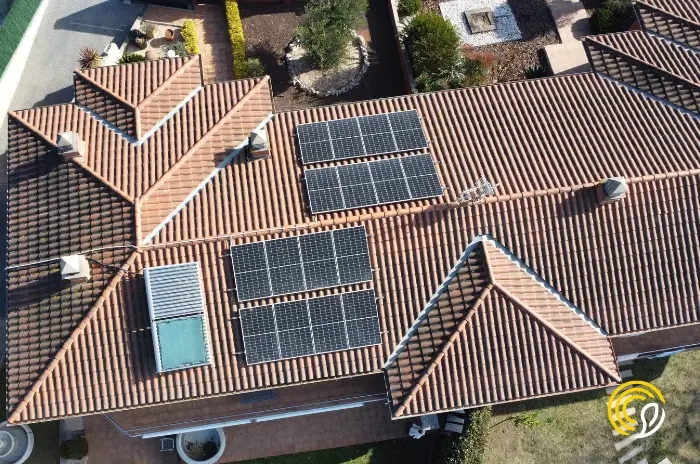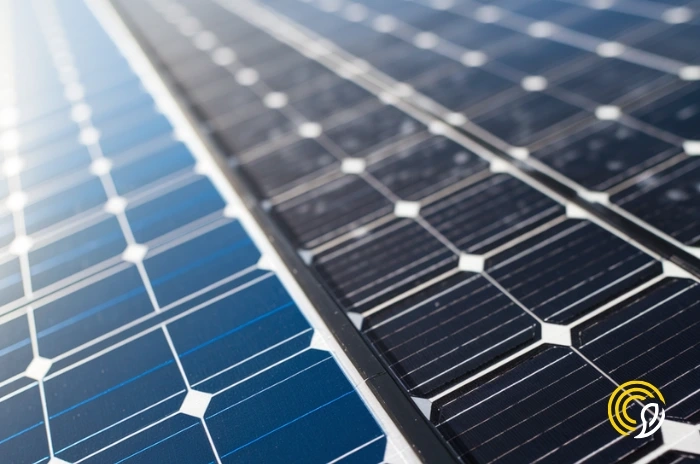
Differences Between Photovoltaic and Thermal Solar Energy

Claudia Pardo, Content Specialist at Sunhero and a firm believer that solar energy can transform the world.
25/10/2024
3 min read
Table of Contents
Photovoltaic solar energy and thermal solar energy are two technologies that harness the sun’s power to generate clean energy, although each works differently and is designed for specific uses.
In this post, we will explain in detail the differences between these two types of solar energy. We’ll explore how they work, their benefits, and limitations, and see in which situations one or the other system is more convenient to use.
Photovoltaic solar energy
Photovoltaic energy converts sunlight into electricity through solar panels made up of silicon photovoltaic cells.
This process, known as the photovoltaic effect, occurs when photons from sunlight hit the cells, causing electrons to move and generating a direct electric current, which is then converted into alternating current, ready for use in homes, companies, or even to be fed into the grid.
It is especially useful in regions with good solar radiation, as it allows users to reduce their dependence on the conventional electric grid and generate clean energy without emissions.
Although the initial investment can be somewhat higher, the benefits that photovoltaic solar energy offers are highly appealing.
Advantages
- Generation of Clean and Sustainable Energy: Since it does not produce polluting gas emissions during operation, photovoltaic energy actively contributes to decarbonization and reducing the carbon footprint, aligning with global sustainability and energy transition goals.
- High Durability and Low Maintenance: Photovoltaic solar panels are known for their resilience and longevity, with a useful life of 25 to 30 years. Their maintenance is minimal, involving periodic cleaning and annual technical inspections, making them a long-term, accessible energy option.
- Reduced Energy Costs: By producing their own electricity, users reduce their dependence on the grid, which translates to savings on energy bills. In some regions, it is possible to inject excess production into the grid, generating additional income and optimizing the return on investment.
Disadvantages
- Initial Investment: Implementing a photovoltaic system requires an initial investment, which, although it pays off over time through electricity savings and tax incentives in some areas, can be a barrier for some users.
- Variability in Energy Production: System efficiency depends on solar irradiation, which can be affected by climate and geography. In areas with lower solar exposure or on cloudy days, electricity generation decreases, making storage systems advisable to optimize performance.
Thermal solar energy
Thermal solar energy, on the other hand, transforms solar radiation into heat for heating and hot water purposes.
It uses solar thermal collectors that concentrate solar radiation on a fluid, such as water or oil, which is transferred to a thermal storage system for later use. This system is ideal for domestic heating, hot water supply, and certain industrial processes that require heat.
Solar thermal collectors are divided into several types, depending on the temperature reached. Low-temperature collectors, for example, are most commonly used for heating sanitary water, while medium- and high-temperature collectors are used in industry for processes that require higher thermal capacity.
Advantages
- High Efficiency in Heat Generation: Solar thermal energy uses solar radiation very efficiently for water heating and space heating, potentially covering up to 70% of a household’s thermal needs, significantly reducing the consumption of conventional energy sources.
- Heat Storage Capability: Unlike other renewable sources, solar thermal energy allows heat storage, facilitating its use even during periods of low or no solar radiation, providing greater system flexibility.
Disadvantages
- Space and Orientation Requirements: Solar thermal collectors take up more space than photovoltaic panels and require specific orientation to maximize energy capture, which can limit their implementation in some residential or commercial spaces.
- Lifespan and Maintenance Requirements: With a general lifespan of 10 to 15 years, solar thermal systems require more extensive maintenance than photovoltaic systems, including fluid replacement and periodic technical inspections to ensure optimal operation.
Which is the best option?
The choice between photovoltaic and thermal solar energy depends on the user’s needs and the environment where the system will be installed.
Photovoltaics are ideal for those who want to reduce their electricity bill and achieve greater energy independence, while thermal energy is highly efficient for heating and hot water in homes or installations that require heat.
In many cases, combining both systems allows energy consumption to be optimized and provides a complete solution.
Benefits of photovoltaic solar energy today
Today, photovoltaic solar energy stands as one of the most effective solutions to reduce dependence on the electric grid and decrease CO₂ emissions. With the reduction in installation costs seen in recent years and continued government support, more and more homes and businesses are adopting this technology as an efficient and sustainable alternative.
By allowing users to generate and store their own electricity, photovoltaic solar energy not only significantly reduces energy bills but also increases energy independence.
At Sunhero, we are specialists in the installation of photovoltaic systems for both residences and businesses, dedicated to maximizing each system’s performance for our clients. We offer personalized solutions that range from initial analysis to installation and continuous monitoring, ensuring optimal and long-lasting operation.
Start today!
Fill out our free solar calculator and get a custom quotation







































